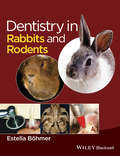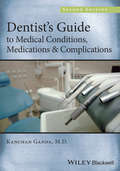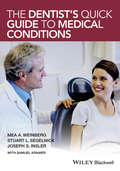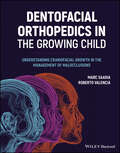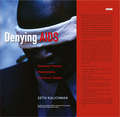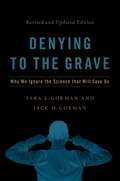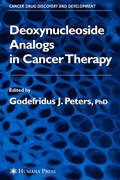- Table View
- List View
Dental Wear in Evolutionary and Biocultural Contexts
by Christopher W. Schmidt James T. WatsonDental Wear in Evolutionary and Biocultural Contexts provides a single source for disseminating the current state-of-the-art research regarding dental wear across a variety of hominoid species under a number of temporal and spatial contexts. The volume begins with a brief introductory chapter addressing the general history, understandings and approaches to the study of dental wear. Remaining chapters cover dental macrowear and dental microwear. Students and professionals in anthropology, specifically paleoanthropologists, bioarcheologists, archaeologists, and primatologists will find this book to be a valuable resource. In addition, it is a helpful guide for dentists and other dental professionals interested in dental function.Covers a wide range of topics, including method and theory, macrowear and microwear in primates, and fossil homininsHighlights several recent technological innovations, including occlusal fingerprinting, considerations of enamel mechanical properties, and microwear textureIncludes case studies from archaeological populations
Dentine Hypersensitivity: Advances in Diagnosis, Management, and Treatment
by David G. GillamThis book provides wide-ranging information on the progress achieved in the diagnosis, treatment and management of dentine hypersensitivity during the past few years. Recent advances in research, including innovations in the development of desensitizing agents, are fully described and detailed attention is paid to novel clinical approaches and potential future strategies in product development. Introductory chapters cover important aspects of physiology, prevalence and aetiology and advances in diagnosis and in vitro testing techniques for dentine hypersensitivity are discussed. Dentine hypersensitivity is a troublesome clinical condition that continues to perplex the clinician despite the vast array of available treatments that have been formulated to resolve the problem. There continues to be under-reporting of the condition by clinicians and uncertainty over aetiology, diagnosis and effective management. This book will hopefully contribute in combating these deficiencies and assist the clinician in delivering optimal patient care.
The Dentist: The must-read thriller with an unforgettable detective in 2024 (A DS Cross Thriller)
by Tim Sullivan'A perfect detective for our time' Stephen FryA cold case that has been ignored... A detective who fights for the voiceless.THE DETECTIVEBristol detective DS George Cross might be difficult to work with – but his unfailing logic and determined pursuit of the truth means he is second to none at convicting killers.THE CRIMEWhen the police dismiss a man's death as a squabble among the homeless community, Cross is not convinced; there are too many unanswered questions.Who was the unknown man whose weather-beaten body was discovered on Clifton Downs? And was the same tragedy that resulted in his life on the streets also responsible for his death?THE COLD CASEAs Cross delves into the dead man's past, he discovers that the answers lie in a case that has been cold for fifteen years.Cross is the only person who can unpick the decades-old murder – after all, who better to decipher the life of a person who society has forgotten than a man who has always felt like an outsider himself?Perfect for fans of M.W. Craven, Peter James and Joy Ellis, The Dentist is part of the DS George Cross thriller series, which can be read in any order.ALSO IN THE DS CROSS THRILLER SERIES#1 THE DENTIST#2 THE CYCLIST#3 THE PATIENT#4 THE POLITICIAN#5 THE MONK#6 THE TEACHER#7 COMING SOON...CROSS CHRONICLE SHORT STORIESTHE LOST BOYSTHE EX-WIFEWhy readers love George Cross...'A clever mystery full of tension but also humour and compassion. George Cross is becoming one of my favourite detectives.' Elly Griffiths'In DS George Cross, Tim Sullivan has created a character who is as endearing as any I've ever come across in this genre. His quirks are his gift, and with Sullivan's tremendous plotting and superb writing, this series is a gift to readers.' Liz Nugent'The fact that Cross has been diagnosed with autism spectrum disorder makes him just as intriguing as the murder mystery' The Times'A British detective for the 21st century who will be hard to forget' Daily Mail 'A compelling, suspenseful police procedural with an intimate, positive insight into living on the autistic spectrum' Woman'An excellent, excellent read' Reader Review
Dentistry at a Glance (At a Glance (Dentistry))
by Elizabeth KayA fully illustrated, concise and accessible introduction to the study of dentistry Central title in the At a Glance series for dentistry students Covers the entire undergraduate clinical dentistry curriculum Topics presented as clear double-page spreads in the recognizable At a Glance style Contributions from leading figures across the field of dentistry Companion website with self-assessment MCQs and further reading
Dentistry at a Glance (At a Glance (Dentistry))
by Elizabeth KayA fully illustrated, concise and accessible introduction to the study of dentistry Central title in the At a Glance series for dentistry students Covers the entire undergraduate clinical dentistry curriculum Topics presented as clear double-page spreads in the recognizable At a Glance style Contributions from leading figures across the field of dentistry Companion website with self-assessment MCQs and further reading
Dentistry, Dental Practice, and the Community - E-Book
by Brian A. Burt Steven A. EklundThis great resource presents dentistry and dental practice against the ever-changing backdrop of economic, technological, and demographic trends, as well as the distribution of the oral diseases that dental professionals treat and prevent. The text is logically divided into five parts. Dentistry and the Community deals with the development of the dental and dental hygiene professions, demographics of the public, its use of dental services, and the professional role. Dental Practice covers the structure and financing of dental care, the personnel involved in providing that care, and the emerging field of evidence-based dentistry. The Methods of Oral Epidemiology provides a comprehensive assessment of the epidemiology of oral diseases and the determinants of their distribution in society. The Distribution of Oral Diseases and Conditions gives a detailed presentation of how the common oral diseases are distributed in the community. Prevention of Oral Diseases in Public Health discusses methods of preventing oral diseases in dental practice and through public health action.Thorough explanations of how to read dental literature help readers understand how to draw their own conclusions from the latest studies.Coverage presents a number of complex problems facing practitioners today regarding access to dental care, and discusses how to solve them by working with public authorities and insurers.Comprehensive coverage of oral disease distribution helps readers to understand trends and risks they will encounter in the field.Material on prevention and control of oral diseases provides important information that all dental practitioners should have.Research designs used in oral epidemology assess the pros and cons of dental indexes available, allowing readers to gain an understanding of the complexities of disease measurement and research.Detailed content on providing dental care to the American public presents a unique opportunity to learn the system of dental care delivery.State-of-the-art coverage of mercury issues offer a balanced view of issues like toxicity, potential hazards, review of evidence, and politics.Ethical guidelines provide a discussion of how ethical principles have evolved over time and the precipitating events that pushed ethical practice into the forefront of health care.Information on the development of dental professions gives readers insight into how these professions originated and their current state.· Content addresses evidence-based dentistry, and how it can and should become part of the everyday clinical life of the practitioner, since staying current is vital to providing excellent patient care.· Discussions of infection control procedures and the impact of HIV and Hepatitis B incorporate new, updated guidelines in dental health care settings released in 2003.
Dentistry in Rabbits and Rodents
by Estella BöhmerDentistry in Rabbits and Rodents is a practical guide aimed at helping clinicians successfully diagnose and treat dental problems in rabbits and rodents within their own surgeries. With over two-thirds of small mammals presenting with tooth related problems, there is great potential to enhance the treatment offered to the owners of these species. Focusing on innovative diagnostics using normal radiographic machines as well as specific positioning techniques, radiographs are presented with reference lines and detailed annotations. Richly illustrated with high quality photographs, pathological findings are described before selection of appropriate therapy and treatment is discussed. Key features include: Covers the dental anatomy and physiology of all small mammal species commonly kept as pets. Intraoral radiography and innovative positioning for imaging the guinea pig and chinchilla dentitions are described, enabling the practitioner to visualize each tooth in detail. Once a diagnosis has been reached, selection of different treatments and the advantages and disadvantages of each surgical technique are discussed. Offers helpful directives for approaching and treating dental disease without the need for referral to a specialist or the use of expensive equipment.
Dentistry in Rabbits and Rodents
by Estella BöhmerDentistry in Rabbits and Rodents is a practical guide aimed at helping clinicians successfully diagnose and treat dental problems in rabbits and rodents within their own surgeries. With over two-thirds of small mammals presenting with tooth related problems, there is great potential to enhance the treatment offered to the owners of these species. Focusing on innovative diagnostics using normal radiographic machines as well as specific positioning techniques, radiographs are presented with reference lines and detailed annotations. Richly illustrated with high quality photographs, pathological findings are described before selection of appropriate therapy and treatment is discussed. Key features include: Covers the dental anatomy and physiology of all small mammal species commonly kept as pets. Intraoral radiography and innovative positioning for imaging the guinea pig and chinchilla dentitions are described, enabling the practitioner to visualize each tooth in detail. Once a diagnosis has been reached, selection of different treatments and the advantages and disadvantages of each surgical technique are discussed. Offers helpful directives for approaching and treating dental disease without the need for referral to a specialist or the use of expensive equipment.
The Dentist's Drug and Prescription Guide
by Mea A. Weinberg Stuart J. FroumA Critical Resource with Information You Won't Find Anywhere Else. Dentists of all specialties prescribe drugs for their patients, from pain medications to sedatives to antibiotics, and know all too well that making an evidenced-based decision on which drug to prescribe is more than just looking up a drug on the computer or PDA and requires more comprehensive consideration than the current drug reference books offer. For example, should an antibiotic be prescribed for implant placement or for sinus augmentation procedures? If so, what antibiotic is recommended (backed up with references), when should it be started, and for how long? Which is the antibiotic of choice for an odontogenic infection and how do you know if that antibiotic is working? Improve Your Decision Making with this Essential Guide. The Dentist’s Drug and Prescription Guide is the only book to offer comprehensive coverage of this topic and has quickly become the go-to reference for dental students, general dentists, periodontists, oral surgeons, dental hygienists. Written for dental professionals seeking quick advice on prescribing medications for their patients, the book offers: An easy-to-read question-and-answer format, the text describes evidenced-based pharmacologic therapy with current and up-to-date references regarding adjunctive pharmacologic treatment of the dental patient Easy-to-follow drug tables that summarize the main pharmacologic features of the different disciplines, including periodontics, implantology, oral surgery, and endodontics, with recommendations for pharmacologic treatment with periodontal and implant surgery as well as treatment of periodontal diseases, dental pain, and infection Detailed strategies to manage and prevent drug interactions in the dental practice Instructions and guidelines for the patient on how to take the drugs (e.g., to avoid GI upset when taking antibiotics acidophilus or yogurt can be taken). Plus, sample prescriptions, coverage of proper documentation in the patient's chart, and more! Order your copy today!
The Dentist's Drug and Prescription Guide
by Mea A. Weinberg Stuart J. FroumA Critical Resource with Information You Won't Find Anywhere Else. Dentists of all specialties prescribe drugs for their patients, from pain medications to sedatives to antibiotics, and know all too well that making an evidenced-based decision on which drug to prescribe is more than just looking up a drug on the computer or PDA and requires more comprehensive consideration than the current drug reference books offer. For example, should an antibiotic be prescribed for implant placement or for sinus augmentation procedures? If so, what antibiotic is recommended (backed up with references), when should it be started, and for how long? Which is the antibiotic of choice for an odontogenic infection and how do you know if that antibiotic is working? Improve Your Decision Making with this Essential Guide. The Dentist’s Drug and Prescription Guide is the only book to offer comprehensive coverage of this topic and has quickly become the go-to reference for dental students, general dentists, periodontists, oral surgeons, dental hygienists. Written for dental professionals seeking quick advice on prescribing medications for their patients, the book offers: An easy-to-read question-and-answer format, the text describes evidenced-based pharmacologic therapy with current and up-to-date references regarding adjunctive pharmacologic treatment of the dental patient Easy-to-follow drug tables that summarize the main pharmacologic features of the different disciplines, including periodontics, implantology, oral surgery, and endodontics, with recommendations for pharmacologic treatment with periodontal and implant surgery as well as treatment of periodontal diseases, dental pain, and infection Detailed strategies to manage and prevent drug interactions in the dental practice Instructions and guidelines for the patient on how to take the drugs (e.g., to avoid GI upset when taking antibiotics acidophilus or yogurt can be taken). Plus, sample prescriptions, coverage of proper documentation in the patient's chart, and more! Order your copy today!
The Dentist's Drug and Prescription Guide
by Mea A. Weinberg Stuart J. Froum Stuart L. SegelnickThe updated and authoritative reference to medications used in dental practice The revised and updated second edition of The Dentist's Drug and Prescription Guide offers a practical and quick reference to medications commonly prescribed in dental practice. With contributions from experts on the topic, this comprehensive book takes an accessible question-and-answer format, providing answers to common questions dentists ask about drugs. The most updated information on drugs is presented throughout, including the current antibiotic prophylaxis guidelines and newer osteoporosis drugs. A new section describes how to manage patients on medications, and includes new chapters on the important topics of opioid prescribing and abuse and pain management. Alternative effective medications for opioids are discussed in detail. Putting all the prescription and drug information needed in daily dental practice at your fingertips, The Dentist's Drug and Prescription Guide is an essential reference for practicing dental clinicians and dental hygienists. This important book: Offers a comprehensive and accessible guide to essential information about medications used in dental practice Presents detailed information about drugs in an easy-to-use question-and-answer format Provides answers to commonly asked questions about drugs Refers to current, evidence-based pharmacology information, tailored for the dental clinician Features information on opioid prescribing and abuse and pain management Written for both general and specialist dentists and dental hygienists, the revised second edition of The Dentist's Drug and Prescription Guide is a must-have reference for the most current information available on medications used in the dental profession.
The Dentist's Drug and Prescription Guide
by Mea A. Weinberg Stuart J. Froum Stuart L. SegelnickThe updated and authoritative reference to medications used in dental practice The revised and updated second edition of The Dentist's Drug and Prescription Guide offers a practical and quick reference to medications commonly prescribed in dental practice. With contributions from experts on the topic, this comprehensive book takes an accessible question-and-answer format, providing answers to common questions dentists ask about drugs. The most updated information on drugs is presented throughout, including the current antibiotic prophylaxis guidelines and newer osteoporosis drugs. A new section describes how to manage patients on medications, and includes new chapters on the important topics of opioid prescribing and abuse and pain management. Alternative effective medications for opioids are discussed in detail. Putting all the prescription and drug information needed in daily dental practice at your fingertips, The Dentist's Drug and Prescription Guide is an essential reference for practicing dental clinicians and dental hygienists. This important book: Offers a comprehensive and accessible guide to essential information about medications used in dental practice Presents detailed information about drugs in an easy-to-use question-and-answer format Provides answers to commonly asked questions about drugs Refers to current, evidence-based pharmacology information, tailored for the dental clinician Features information on opioid prescribing and abuse and pain management Written for both general and specialist dentists and dental hygienists, the revised second edition of The Dentist's Drug and Prescription Guide is a must-have reference for the most current information available on medications used in the dental profession.
Dentist's Guide to Medical Conditions, Medications and Complications
by Kanchan GandaThe second edition of Dentist's Guide to Medical Conditions, Medications and Complications continues to provide quick-access, clinical information on the dental treatment of patients with common systemic conditions and medical complications. Expanded in this second edition is information about patient medications. Ideal for general practitioners and students in advanced general dentistry programs, the book outlines protocols for treating patients with common conditions, presents essential drug interaction information, and guides the dental professional through prevention and management of in-office medical emergencies.
Dentist's Guide to Medical Conditions, Medications and Complications
by Kanchan GandaThe second edition of Dentist's Guide to Medical Conditions, Medications and Complications continues to provide quick-access, clinical information on the dental treatment of patients with common systemic conditions and medical complications. Expanded in this second edition is information about patient medications. Ideal for general practitioners and students in advanced general dentistry programs, the book outlines protocols for treating patients with common conditions, presents essential drug interaction information, and guides the dental professional through prevention and management of in-office medical emergencies.
The Dentist's Quick Guide to Medical Conditions
by Mea A. Weinberg Stuart L. Segelnick Joseph S. InslerWith increasing numbers of dental patients being elderly or having medical conditions, it is important for the dentist to understand how these conditions may impact dental treatment. The Dentist’s Quick Guide to Medical Conditions presents the relevant information dentists need—symptoms, diagnostic tests, medications prescribed, and dental management—for each disease and condition. Chapters will focus on each major bodily system, including respiratory, cardiovascular, hematologic, endocrine, gastrointestinal, immune, nervous, reproductive, and urinary, as well as chapters on the liver, kidneys, skin, and psychological conditions. Appendices list guidelines for antibiotic prophylaxis, additional conditions requiring antibiotics, and a quick list of diagnostic tests.
The Dentist's Quick Guide to Medical Conditions
by Mea A. Weinberg Stuart L. Segelnick Joseph S. InslerWith increasing numbers of dental patients being elderly or having medical conditions, it is important for the dentist to understand how these conditions may impact dental treatment. The Dentist’s Quick Guide to Medical Conditions presents the relevant information dentists need—symptoms, diagnostic tests, medications prescribed, and dental management—for each disease and condition. Chapters will focus on each major bodily system, including respiratory, cardiovascular, hematologic, endocrine, gastrointestinal, immune, nervous, reproductive, and urinary, as well as chapters on the liver, kidneys, skin, and psychological conditions. Appendices list guidelines for antibiotic prophylaxis, additional conditions requiring antibiotics, and a quick list of diagnostic tests.
Dentofacial and Occlusal Asymmetries
by Birte Melsen Athanasios E. AthanasiouComprehensive and accessible resource that covers all crucial aspects of dentofacial and occlusal asymmetries Dentofacial and Occlusal Asymmetries covers all crucial aspects of asymmetries encountered in the stomatognathic region regarding diagnosis, treatment planning, management, and prognosis. Divided into three core sections, the first part focuses on the etiology of asymmetry and whether it is congenital or acquired through disease or trauma. The second and third sections go on to discuss localization and management, providing information on topics such as interception, correction, and camouflage. Specific sample topics covered in the book include: Treatment approaches: interceptive, tooth movements, goal-oriented biomechanics, and jaw repositioningTreatment principles: dentofacial orthopedics, camouflage, and orthodontic-surgical treatmentLocalization and problem list: medical and dental history, clinical examination, dental cast analysis, and radiographic/imaging assessmentMedical, social and psychological aspects: growth disorders and helping children and their families with facial differences Written by a team of renowned experts in the field, Dentofacial and Occlusal Asymmetries will serve as an invaluable resource to postgraduates in orthodontic, pediatric dentistry, and oral and maxillofacial surgery programs as well as orthodontists, pediatric dentists, pediatricians, and oral and maxillofacial surgeons aiming for optimal results in the diagnosis and management of these complex malocclusions and dentofacial deformities.
Dentofacial and Occlusal Asymmetries
by Birte Melsen Athanasios E. AthanasiouComprehensive and accessible resource that covers all crucial aspects of dentofacial and occlusal asymmetries Dentofacial and Occlusal Asymmetries covers all crucial aspects of asymmetries encountered in the stomatognathic region regarding diagnosis, treatment planning, management, and prognosis. Divided into three core sections, the first part focuses on the etiology of asymmetry and whether it is congenital or acquired through disease or trauma. The second and third sections go on to discuss localization and management, providing information on topics such as interception, correction, and camouflage. Specific sample topics covered in the book include: Treatment approaches: interceptive, tooth movements, goal-oriented biomechanics, and jaw repositioningTreatment principles: dentofacial orthopedics, camouflage, and orthodontic-surgical treatmentLocalization and problem list: medical and dental history, clinical examination, dental cast analysis, and radiographic/imaging assessmentMedical, social and psychological aspects: growth disorders and helping children and their families with facial differences Written by a team of renowned experts in the field, Dentofacial and Occlusal Asymmetries will serve as an invaluable resource to postgraduates in orthodontic, pediatric dentistry, and oral and maxillofacial surgery programs as well as orthodontists, pediatric dentists, pediatricians, and oral and maxillofacial surgeons aiming for optimal results in the diagnosis and management of these complex malocclusions and dentofacial deformities.
Dentofacial Anomalies: Implications for Voice and Wind Instrument Performance
by Abdul Latif Hamdan Robert Thayer Sataloff Valerie Trollinger Mary J. HawkshawThis volume provides an eloquent review of the anatomy and physiology of phonation, the work-up of patients with voice disorders, basic evaluation of wind instrument performance and dysfunction, and a full description of the most common skeletal and non-skeletal dentofacial anomalies, including their means of diagnosis and treatment. This is followed by a comprehensive review of literature on the vocal and acoustic features of affected patients, as well as the special considerations in wind instrumentalists. The effect of orthodontic therapy/ orthognathic surgery on voice, associated upper airway changes, and wind instruments performance is emphasized. The information provided in this book will heighten the patients’, therapists’, teachers’ and physicians’ awareness of the vocal characteristics and wind instrumentalists concerns often associated with these conditions. Dentofacial Anomalies: Implications for Voice and Wind Instrument Performance is addressed to otolaryngologists, laryngologists, speech-language pathologists, voice teachers, professional voice users, wind instrumentalists, instrument teachers, arts medicine physicians, physical therapists, orthodontists and other dentists, as well as members of the general public who are concerned about their voices and or wind instrument playing.
Dentofacial Orthopedics in the Growing Child: Understanding Craniofacial Growth in the Management of Malocclusions
by Marc Saadia Roberto ValenciaDENTOFACIAL ORTHOPEDICS IN THE GROWING CHILD A clinical guide to understanding why malocclusions occur in children and how to diagnose and correct them early to reestablish normal growth using dentofacial orthopedics Dentofacial Orthopedics in the Growing Child: Understanding Craniofacial Growth and the Management of Malocclusion provides step-by-step guidance on diagnosing and treating malocclusions in young patients. The book addresses both class I, II and III malocclusions, and more complicated cases such as facial asymmetries and temporomandibular problems that develop in the primary dentition. Concise, highly illustrated chapters describe normal and abnormal craniofacial development, and how and why environmental factors can affect the growth pattern. Early diagnosis and treatment planning, long-term case resolution, complementary methods of diagnosis such as occlusion and cephalometric, and more are discussed. Provides clinicians with visual guidance on how to rapidly diagnose malocclusions Contains over 1,300 high-quality images of different Class I, Class II, and Class III malocclusions, including temporomandibular problems, both before and after correction, and long-term follow-ups Helps clinicians correct different malocclusions using the fewest number of appliances and in the least amount of time Includes tables of different cephalometric of before and after corrections for most clinical cases presented in the book Contains a chapter on how to communicate and bond with children as patients to help them understand the importance of wearing their appliances Children are not young adults so diagnostic methods which are regularly used can often misguide the clinician. Dentofacial Orthopedics in the Growing Child is an invaluable reference that guides pediatric dentists, orthodontists, general dentists, and maxillofacial and craniofacial surgeons with treating children.
Dentofacial Orthopedics in the Growing Child: Understanding Craniofacial Growth in the Management of Malocclusions
by Marc Saadia Roberto ValenciaDENTOFACIAL ORTHOPEDICS IN THE GROWING CHILD A clinical guide to understanding why malocclusions occur in children and how to diagnose and correct them early to reestablish normal growth using dentofacial orthopedics Dentofacial Orthopedics in the Growing Child: Understanding Craniofacial Growth and the Management of Malocclusion provides step-by-step guidance on diagnosing and treating malocclusions in young patients. The book addresses both class I, II and III malocclusions, and more complicated cases such as facial asymmetries and temporomandibular problems that develop in the primary dentition. Concise, highly illustrated chapters describe normal and abnormal craniofacial development, and how and why environmental factors can affect the growth pattern. Early diagnosis and treatment planning, long-term case resolution, complementary methods of diagnosis such as occlusion and cephalometric, and more are discussed. Provides clinicians with visual guidance on how to rapidly diagnose malocclusions Contains over 1,300 high-quality images of different Class I, Class II, and Class III malocclusions, including temporomandibular problems, both before and after correction, and long-term follow-ups Helps clinicians correct different malocclusions using the fewest number of appliances and in the least amount of time Includes tables of different cephalometric of before and after corrections for most clinical cases presented in the book Contains a chapter on how to communicate and bond with children as patients to help them understand the importance of wearing their appliances Children are not young adults so diagnostic methods which are regularly used can often misguide the clinician. Dentofacial Orthopedics in the Growing Child is an invaluable reference that guides pediatric dentists, orthodontists, general dentists, and maxillofacial and craniofacial surgeons with treating children.
Denying AIDS: Conspiracy Theories, Pseudoscience, and Human Tragedy
by Seth C. KalichmanParalleling the discovery of HIV and the rise of the AIDS pandemic, a flock of naysayers has dedicated itself to replacing genuine knowledge with destructive misinformation—and spreading from the fringe to the mainstream media and the think tank. Now from the editor of the journal AIDS and Behavior comes a bold exposé of the scientific and sociopolitical forces involved in this toxic evasion. Denying AIDS traces the origins of AIDS dissidents disclaimers during the earliest days of the epidemic and delves into the psychology and politics of the current denial movement in its various incarnations. Seth Kalichman focuses not on the “difficult” or doubting patient, but on organized, widespread forms of denial (including the idea that HIV itself is a myth and HIV treatments are poison) and the junk science, faulty logic, conspiracy theories, and larger forces of homophobia and racism that fuel them. The malignant results of AIDS denial can be seen in those individuals who refuse to be tested, ignore their diagnoses, or reject the treatments that could save their lives. Instead of ignoring these currents, asserts Kalichman, science has a duty to counter them. Among the topics covered: Why AIDS denialism endures, and why science must understand it. Pioneer virus HIV researcher Peter Duesberg’s role in AIDS denialism. Flawed immunological, virological, and pharmacological pseudoscience studies that are central to texts of denialism. The social conservative agenda and the politics of AIDS denial, from the courts to the White House. The impact of HIV misinformation on public health in South Africa. Fighting fiction with reality: anti-denialism and the scientific community. For anyone affected by, interested in, or working with researchers in HIV/AIDS, and public health professionals in general, the insight and vision of Denying AIDS will inspire outrage, discussion, and ultimately action. See http://denyingaids.blogspot.com/ for more information.
Denying to the Grave: Why We Ignore the Science That Will Save Us, Revised and Updated Edition
by Jack M. Gorman Sara E. GormanWith science denial as a rising danger to public health, Sara E. Gorman and Jack M. Gorman analyze society's resistance to scientific evidence relating to health and safety, and the tools to combat these tendencies. Why do some parents decide not to vaccinate their children? Why do some people keep guns at home, despite ample evidence that doing so increases the risk of a gun-related injury? And why do people use antibiotics for illnesses that antibiotics cannot possibly alleviate? When it comes to health, many people believe that science is wrong, that the evidence is incomplete, and that unidentified hazards lurk everywhere. In Denying to the Grave, Sara Gorman and Jack Gorman explore the psychology of health science denial. Using several examples as case studies, they propose six key principles that may lead people to reject "accepted" health-related wisdom: the charismatic leader; fear of complexity; confirmation bias; fear of corporate and government conspiracies; causality and filling the ignorance gap; and the nature of risk prediction. This fully updated and expanded new edition of Denying to the Grave reviews the most recent research on health science denial, offering a brand new chapter on how the contemporary "assault on science" waged by certain political administrations has eroded public trust in national health and science agencies, such as CDC, FDA, and EPA. Also new to this edition is a chapter investigating the relationship between health crises and misinformation, and what happens to science denial amidst a global public health crisis. Finally, the book proposes a novel approach to counteracting misinformation and improving our ability to understand and accept scientific consensus. In an era in which trust in science has become more important, and yet more elusive, than ever before, Denying to the Grave sheds light on why we often choose to ignore scientific evidence, pointing the way toward a new understanding of how science should be conveyed to the public in order to save lives with existing knowledge and technology.
Denying to the Grave: Why We Ignore the Science That Will Save Us, Revised and Updated Edition
by Sara E. Gorman Jack M. GormanWith science denial as a rising danger to public health, Sara E. Gorman and Jack M. Gorman analyze society's resistance to scientific evidence relating to health and safety, and the tools to combat these tendencies. Why do some parents decide not to vaccinate their children? Why do some people keep guns at home, despite ample evidence that doing so increases the risk of a gun-related injury? And why do people use antibiotics for illnesses that antibiotics cannot possibly alleviate? When it comes to health, many people believe that science is wrong, that the evidence is incomplete, and that unidentified hazards lurk everywhere. In Denying to the Grave, Sara Gorman and Jack Gorman explore the psychology of health science denial. Using several examples as case studies, they propose six key principles that may lead people to reject "accepted" health-related wisdom: the charismatic leader; fear of complexity; confirmation bias; fear of corporate and government conspiracies; causality and filling the ignorance gap; and the nature of risk prediction. This fully updated and expanded new edition of Denying to the Grave reviews the most recent research on health science denial, offering a brand new chapter on how the contemporary "assault on science" waged by certain political administrations has eroded public trust in national health and science agencies, such as CDC, FDA, and EPA. Also new to this edition is a chapter investigating the relationship between health crises and misinformation, and what happens to science denial amidst a global public health crisis. Finally, the book proposes a novel approach to counteracting misinformation and improving our ability to understand and accept scientific consensus. In an era in which trust in science has become more important, and yet more elusive, than ever before, Denying to the Grave sheds light on why we often choose to ignore scientific evidence, pointing the way toward a new understanding of how science should be conveyed to the public in order to save lives with existing knowledge and technology.
Deoxynucleoside Analogs in Cancer Therapy (Cancer Drug Discovery and Development)
by Godefridus J. PetersSuccessful cancer chemotherapy relies heavily on the application of various deoxynucleoside analogs. Since the very beginning of modern cancer chemotherapy, a number of antimetabolites have been introduced into the clinic and subsequently applied widely for the treatment of many malignancies, both solid tumors and hematological disorders. In the latter diseases, cytarabine has been the mainstay of treatment of acute myeloid leukemia. Although many novel compounds were synthesized in the 1980s and 1990s, no real improvement was made. However, novel technology is now capable of elucidating the molecular basis of several inborn errors as well as some specific malignancies. This has enabled the synthesis of several deoxynucleoside analogs that could be applied for specific malignancies, such as pentostatin and subsequently chlorodeoxyadenosine (cladribine) for the treatment of hairy cell leukemia. Already in the early stage of deoxynucleoside analog development, it was recognized that several of these compounds were very effective in the treatment of various viral infections, such as for the treatment of herpes infections. This formed the basis initially for the design of azidothymidine and subsequently many other analogs, which are currently successfully used for the treatment of HIV infections. As a spin-off of these research lines, some compounds not eligible for development as antiviral agents appeared to be very potent anticancer agents. The classical example is gemcitabine, now one of the most widely applied deoxynucleoside analogs, used for the (combination) treatment of non-small cell lung cancer, pancreatic cancer, bladder cancer, and ovarian cancer.





